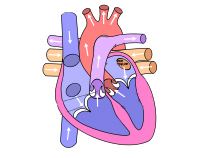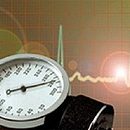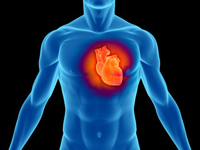Aorta is the largest blood vessel in the body, which pumps the arterial blood. The main manifestations of the disease are pain in the heart, compressive nature, dizziness and even faint.
Content
Aorta - the largest vessel of the human body comes out of the left ventricle of the heart. It carries arterial blood from the heart under high pressure, provided with a reduction in the powerful muscle of the left ventricle, then on systems of large and small arteries and arterioles, rich in oxygen blood reaches each body cell. The heart pumped the heart in the systole phase and in order to relax the ventricle, in the diastole phase, when the pressure in the left ventricle falls, the blood did not return to the gastroincing cavity, the aortic valve is at the entrance to the aorta. It consists of three seaside flaps.
Symptoms of aortic insufficiency
 With different lesions of the valve valve, the flaps can be frozen, thickened, and the hole from the left ventricle in the aorta does not close completely. There is a reverse blood flow from the aorta to the ventricle - there is deficiency of the aortic valve. Additional blood volume entering into the left ventricle causes the ventricle's muscle to work with greater force. This muscle is hypertrophy, thickened. Powerful left ventricle can compensate for quite a long time. However, over time the muscle stretches, the strength of the reduction falls and heart failure arises.
With different lesions of the valve valve, the flaps can be frozen, thickened, and the hole from the left ventricle in the aorta does not close completely. There is a reverse blood flow from the aorta to the ventricle - there is deficiency of the aortic valve. Additional blood volume entering into the left ventricle causes the ventricle's muscle to work with greater force. This muscle is hypertrophy, thickened. Powerful left ventricle can compensate for quite a long time. However, over time the muscle stretches, the strength of the reduction falls and heart failure arises.
Patients suffering from aortic insufficiency long do not complaints. As the disease develops, heartbeats appear, shortness of breath. Pains in the heart of the heart are usually compressive. Because of the deterioration of the blood supply of the brain, dizziness appear, fainting. Since the appearance of complaints, patients with aortic failure without surgical treatment lives 3-5 years. Patient usually pale leather. When decompensation, the skin color acquires ashon. The ripple of the sleepy arteries can be noticeable. It is called «Dance Carotid», May appear with a symptom of Mussy - rhythmic swing head synchronously with a pulse.
Diagnosis of the disease
When listening to the diastolic noise over the aorta, which occurs during the reverse current of blood from the aorta to the left ventricle through the holes in the valve. The upper boundary of blood pressure increases, and the lower boundary falls down to zero. The radiograph is determined by the increase in the left ventricle of the heart, the extension of the aorta. On the electrocardiogram there are signs of increasing left ventricle. In case of echocardiographic examination, the aortic extension is found, the sealing of the aortic valve flaps, the reverse blood flow from the aorta to the left ventricle, determine the degree of damage to the valve.
Methods for treating the lack of aortic valve
Medical treatment of the lack of aortic valve is reduced to the treatment of the underlying disease, if it happens on time. In later stages, this treatment of heart failure.
Surgical treatment of aortic insufficiency. If the lesion of the nuclear aortic valve, plastic is possible aortic valve. For this, various techniques are used. However, with such operations, the risk of re-occurrence of aortic failure and the need for re-operation occurs. Therefore, most patients with this definition of the heart are still recommended for prosthetics of the aorta valve.









